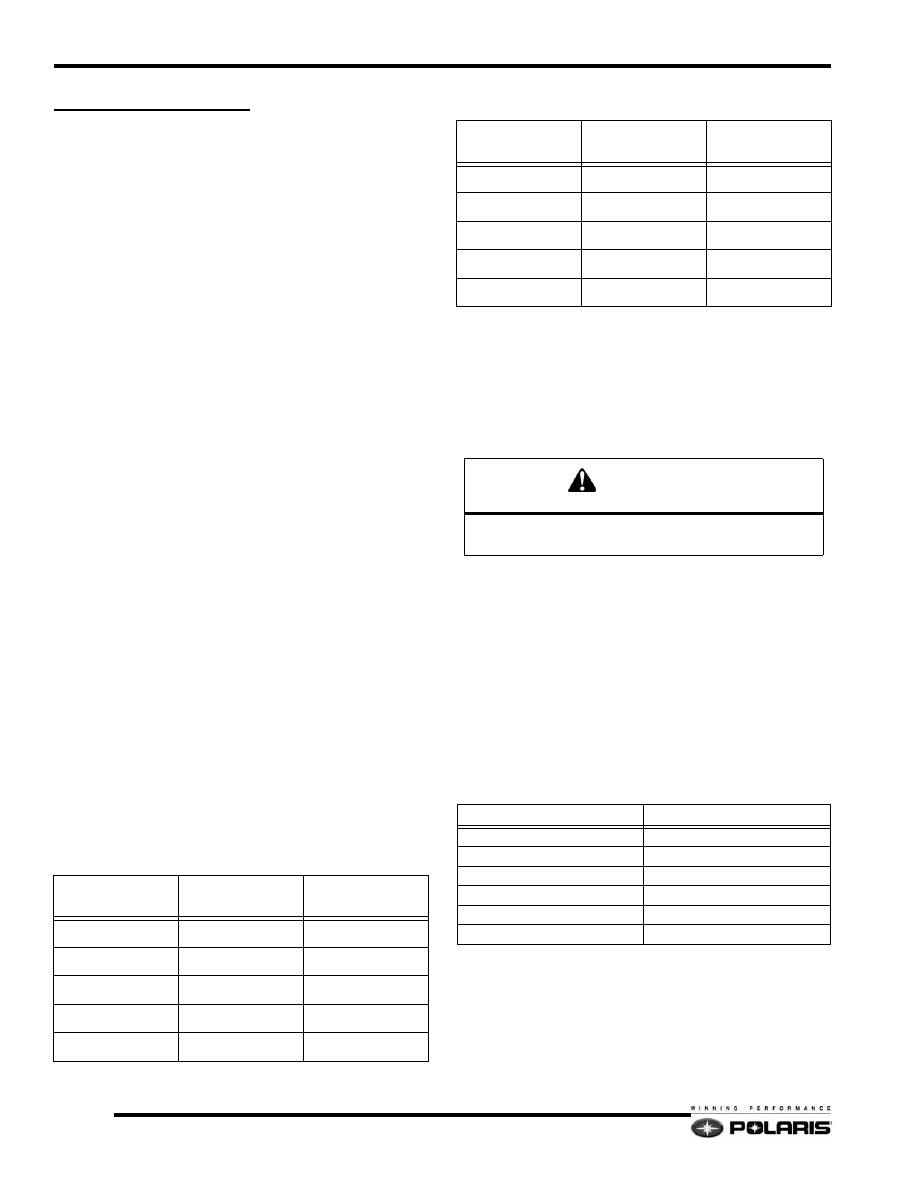Snowmobile Polaris IQ (2007-2008 year). Manual - part 73

11.4
Battery and Electrical Systems
BATTERY TESTING
Testing Procedures
Batteries should be kept at or as near full charge as possible. If
the battery is stored or used in a partially charged condition, hard
crystal sulfication will form on the plates, reducing their
efficiency and possibly ruining the battery.
Open Circuit Voltage Test (OCV)
Check static battery voltage with multimeter. Voltage should be
no less than 12.8 Vdc. Charge battery if voltage is lower than
12.8 Vdc.
Load Test
A battery may pass the OCV test, but still not have the storage
capacity necessary to properly function.
1.
Connect multimeter to the battery as if performing the
OCV test.
2.
Turn the engine over using the electric starter.
3.
Replace battery if Vdc drops below 9.5Vdc.
NOTE: Battery load test tools can be purchased
commercially. Follow the manufactures’ instructions
for use.
Specific Gravity Test (Conventional Battery)
NOTE: Do not attempt to open the vent cover on a
fresh pack battery.
A battery hydrometer (PN 2870836) can be used to measure
electrolyte strength or specific gravity. As the battery goes
through the charge/discharge cycle, the electrolyte goes from a
heavy, more acidic state at full charge to a light, more water state
when discharged. The hydrometer can measure state of charge
and differences between cells in a multi-cell battery. Readings of
1.270 or greater should be observed in a fully charged battery.
Differences of more than 0.025 between the lowest and highest
cell readings indicate a need to replace the battery.
Off Season Storage
To prevent battery damage during extended periods of non-use,
the following maintenance items must be performed.
1.
Remove battery from machine and wash the case and
battery tray with a mild solution of baking soda and water.
Rinse with of fresh water after cleaning.
2.
Using a wire brush or knife, remove any corrosion from the
cables and terminals.
3.
Charge at a rate no greater than 1/10 of the battery's amp/
hr. capacity.
4.
Store the battery in a cool, dry place.
NOTE: Stored batteries lose their charge at the rate
of 1% per day. They should be fully recharged every
30 to 60 days during a non-use period. If stored
during winter months, the electrolyte will freeze at
higher temperatures as the battery discharges.
Battery Voltage
STATE OF CHARGE
CONVENTIONAL
LEAD-ACID
YUMACRON TYPE
100% CHARGED
12.60v
12.70v
75% CHARGED
12.40v
12.50v
50% CHARGED
12.10v
12.20v
25% CHARGED
11.90v
12.00v
0% CHARGED
< 11.80v
< 11.90v
Battery Voltage Per Cell
STATE OF CHARGE
CONVENTIONAL
LEAD-ACID
YUMACRON TYPE
100% CHARGED
1.265v
1.275v
75% CHARGED
1.210v
1.225v
50% CHARGED
1.160v
1.175v
25% CHARGED
1.120v
1.135v
0% CHARGED
< 1.100v
< 1.115v
CAUTION
D
O
NOT
ALLOW
ANY
OF
THE
BAKING
SODA
SOLUTION
TO
ENTER
THE
BATTERY
OR
THE
ACID
WILL
BE
NEUTRALIZED
.
Specific Gravity Freezing Point
Specific Gravity of Electrolyte
Freezing Point
1.265
-75_F (-59_C)
1.225
-35_F (-37_C)
1.200
-17_F (-27_C)
1.150
5_F (-15_C)
1.100
18_F (-8_C)
1.050
27_F (-3_C)